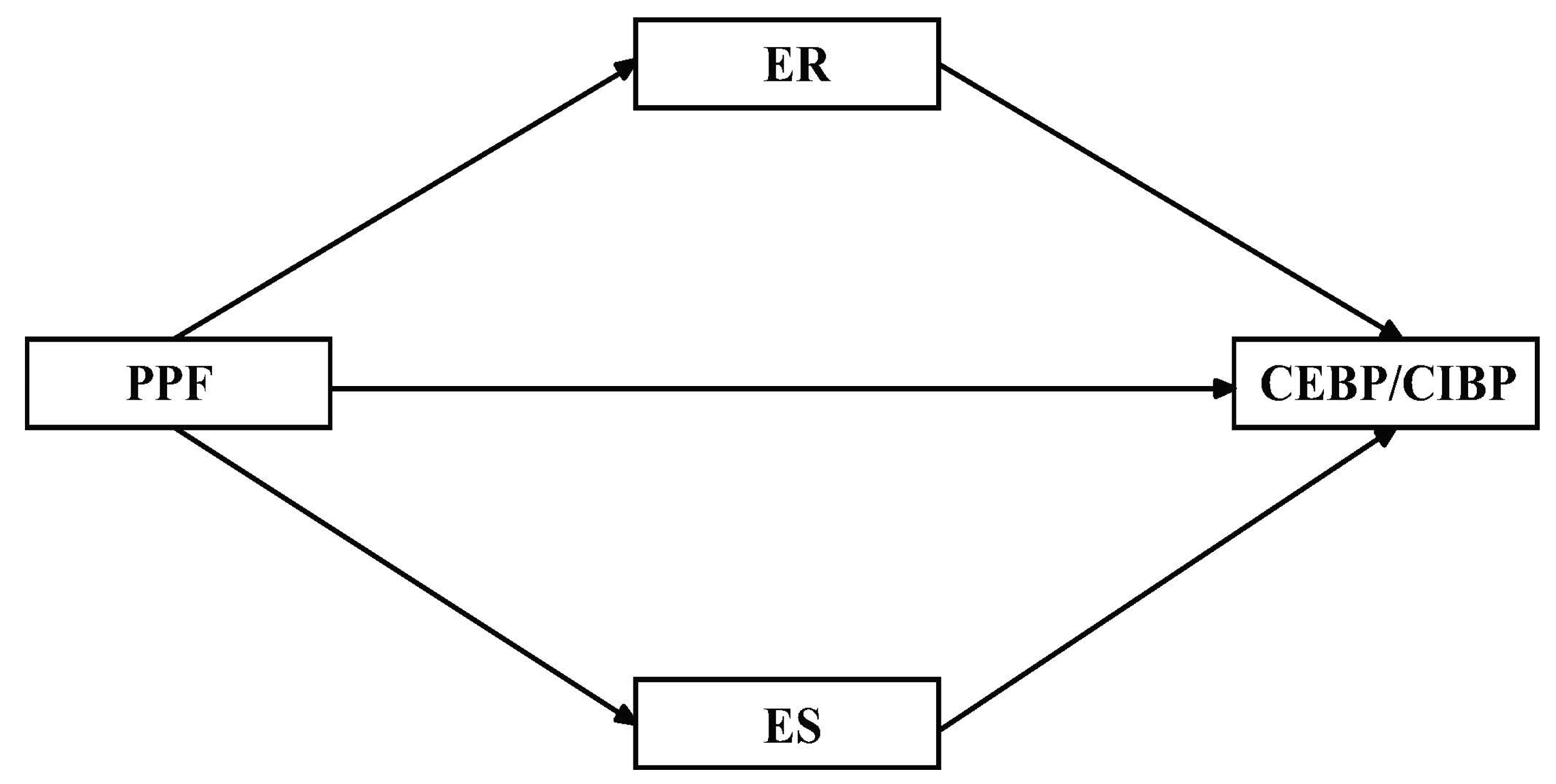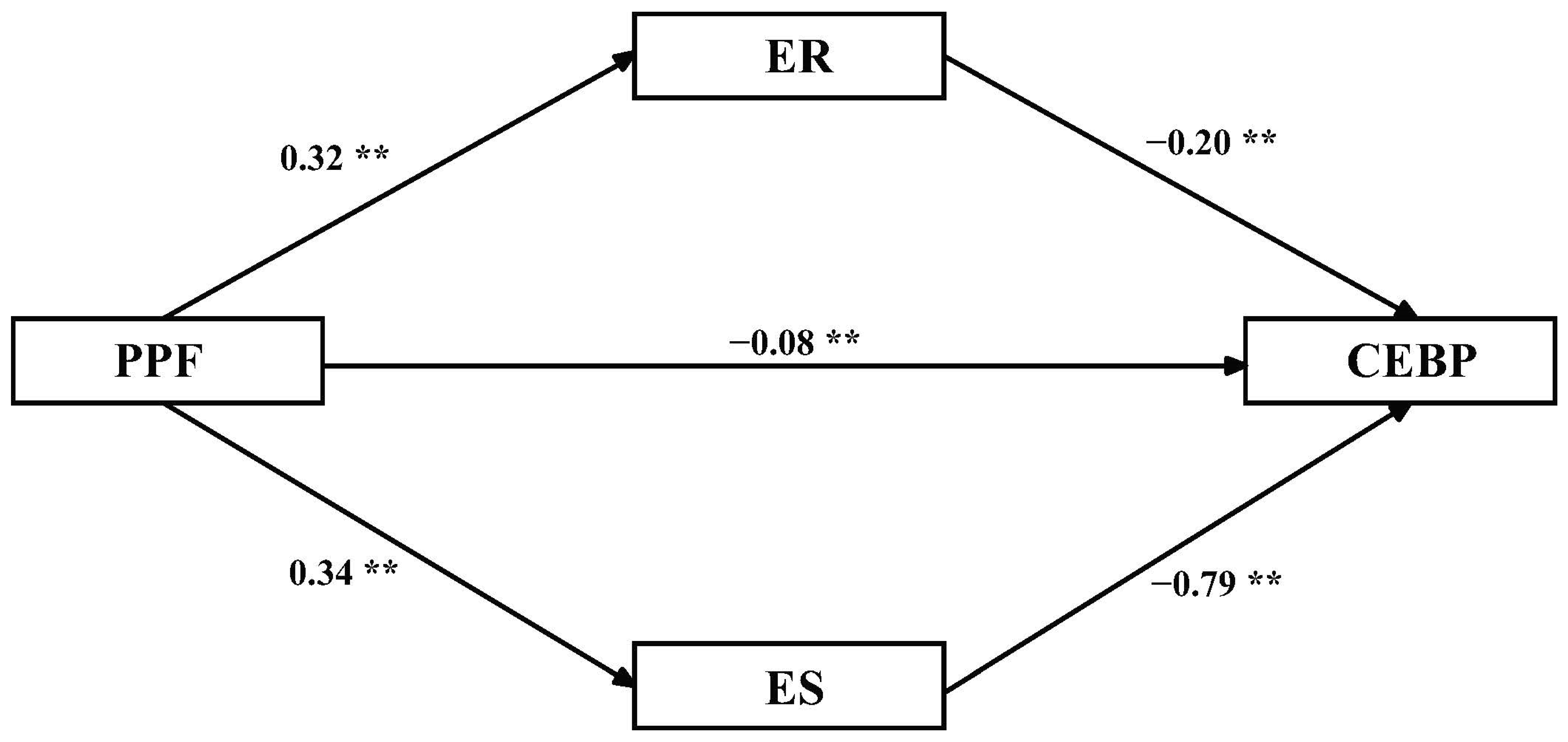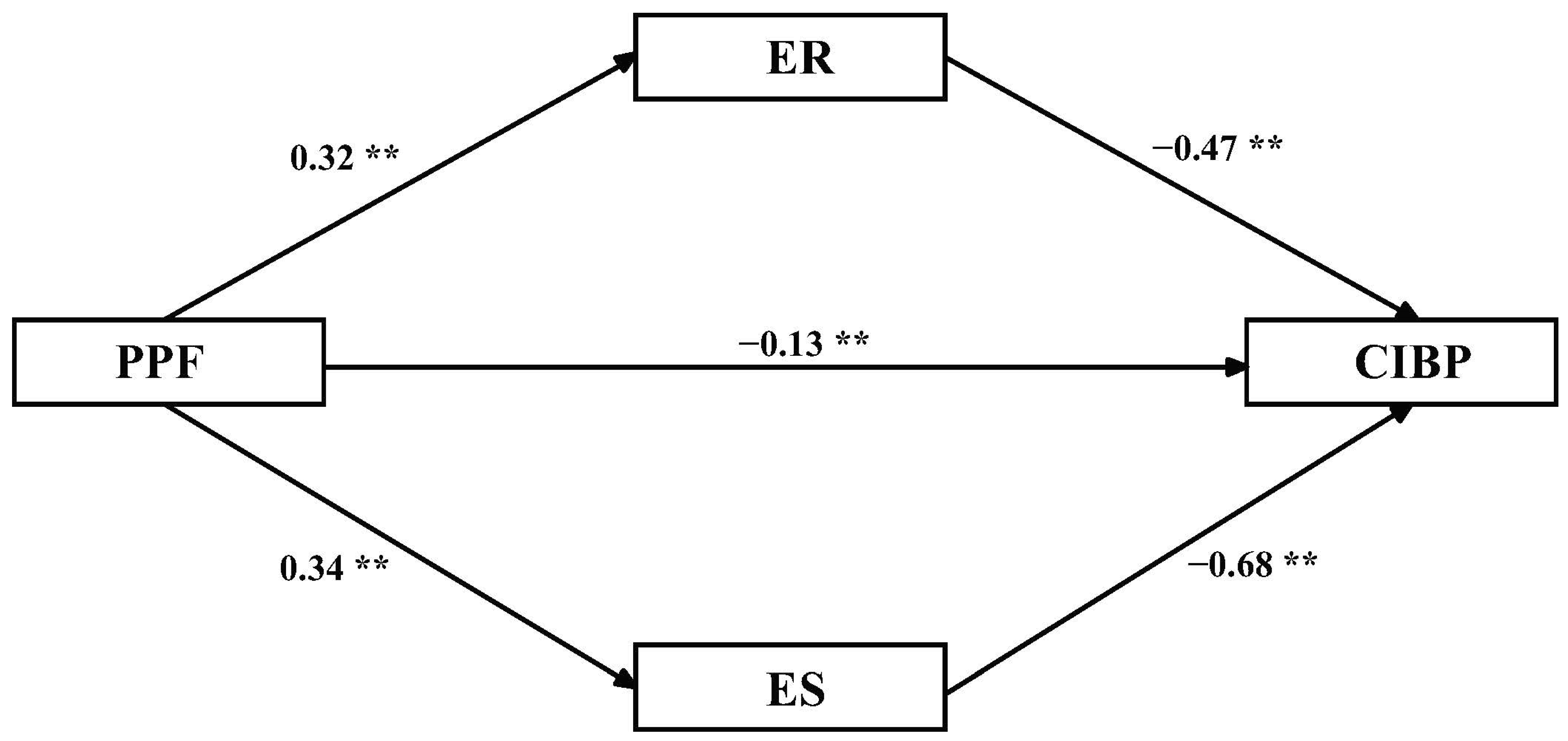Parental Psychological Flexibility and Children’s Behavior Problems in Rural Areas in Northeast China: The Mediation of Children’s Emotion Regulation
Abstract
1. Introduction
1.1. Parental Psychological Flexibility and Children’s Behavior Problems
1.2. Children’s Emotion Regulation and Children’s Behavior Problems
1.3. The Mediating Effect of Children’s Emotion Regulation
1.4. Present Research
2. Materials and Methods
2.1. Participants
2.2. Measures
2.2.1. Parental Psychological Flexibility Questionnaire
2.2.2. Child Behavior Checklist
2.2.3. Emotion Regulation Checklist
2.3. Procedure
2.4. Date Analysis
3. Results
3.1. Correlation Analysis of Parental Psychological Flexibility, Children’s Emotion Regulation, and Children’s Behavior Problems
3.2. Main Effects of Parental Psychological Flexibility and Children’s Emotion Regulation on Children’s Behavior Problems
3.3. The Mediating Roles of Emotional Regulation and Stability
4. Discussion
4.1. Parental Psychological Flexibility and Children’s Emotion Regulation Significantly Negatively Predicted Children’s Behavior Problems
4.2. The Mediating Effect of Emotional Regulation and Stability
4.3. Limitations and Future Directions
5. Conclusions
Author Contributions
Funding
Institutional Review Board Statement
Informed Consent Statement
Data Availability Statement
Acknowledgments
Conflicts of Interest
References
- Achenbach, T.M.; Mcconaughy, S.H.; Howell, C.T. Child/Adolescent Behavioral and Emotional Problems: Implications of Cross-informant Correlations for Situational Specificity. Psychol. Bull. 1987, 101, 213–232. [Google Scholar] [CrossRef] [PubMed]
- Perou, R.; Bitsko, R.H.; Blumberg, S.J.; Pastor, P.; Ghandour, R.M.; Gfroerer, J.C.; Hedden, S.L.; Crosby, A.E.; Visser, S.N.; Schieve, L.A.; et al. Mental health surveillance among children-united states, 2005–2011. MMWR Suppl. 2013, 62, 1–35. [Google Scholar] [PubMed]
- Chi, X.L.; Chen, S.Y.; Wang, Q.Y.; Huang, Q.M.; Han, P.L. Effect of Family Functioning on Behavior Problem in Adolescents: A Moderated Mediating Effect. Chin. J. Clin. Psychol. 2021, 29, 246–251. [Google Scholar]
- Basten, M.; Tiemeier, H.; Althoff, R.R.; van de Schoot, R.; Jaddoe, V.W.V.; Hofman, A.; Hudziak, J.J.; Verhulst, F.C.; van der Ende, J. The Stability of Problem Behavior Across the Preschool Years: An Empirical Approach in The General Population. J. Abnarm. Child Psychol. 2016, 44, 393–404. [Google Scholar] [CrossRef] [PubMed]
- Kessler, R.C.; Berglund, P.; Demler, O.; Jin, R.; Walters, E.E. Lifetime Prevalence and Age-of-onset Distributions of DSM-IV Disorders in the National Comorbidity Survey Replication. Arch. Gen. Psychiat. 2005, 62, 593–602. [Google Scholar] [CrossRef]
- Robins, L.N.; Price, R.K. Adult disorders predicted by childhood conduct problems: Results from the NIMH Epidemiologic Catchment Area Project. Psychiatry 1991, 54, 116–132. [Google Scholar] [CrossRef]
- Kelly, Y.; Sacker, A.; Del Bono, E.; Francesconi, M.; Marmot, M. What Role for the Home Learning Environment and Parenting in Reducing the Socioeconomic Gradient in Child Development? Findings from the Millennium Cohort Study. Arch. Dis. Child. 2011, 96, 832–877. [Google Scholar] [CrossRef]
- Benson, P.L.; Scales, P.C.; Syvertsen, A.K. The contribution of the developmental assets framework to positive youth development theory and practice. Adv. Child Dev. Behav. 2011, 41, 197–230. [Google Scholar]
- Lussier, G.; Deater-Deckard, K.; Dunn, J.; Davies, L. Support across two generations: Children’s closeness to grandparents following parental divorce and remarriage. J. Fam. Psychol. 2002, 16, 363–376. [Google Scholar] [CrossRef]
- Gazelle, H.; Putallaz, M.; Li, Y.; Grimes, C.; Kupersmidt, J.; Coie, J.D. Anxious Solitude Across Contexts: Girls’ Interactions with Familiar and Unfamiliar Peers. Child Dev. 2005, 76, 227–246. [Google Scholar] [CrossRef] [PubMed]
- Wang, Y.J.; Zhang, Y.; Li, Y. Maternal Psychological Flexibility and Six Years Old Children’s Problem Behaviors: The Mediating Role of Parent-Child Relationship. Chin. J. Clin. Psychol. 2021, 29, 118–122. [Google Scholar]
- Chen, Q.; Yu, W.P.; Chen, R.M.; Zhang, J.L.; Wang, L.; Tao, F.B. A Study on the Influence of Preschool Children’s Lifestyle on Emotional and Behavioral Problems. Mod. Prev. Med. 2021, 48, 82–85. [Google Scholar]
- Burke, K.; Moore, S. Development of the Parental Psychological Flexibility Questionnaire. Child Psychiatry Hum. Dev. 2015, 46, 548–557. [Google Scholar] [CrossRef]
- Leeming, E.; Hayes, S.C. Parents are People Too: The importance of Parental Psychological Flexibility. Chin. Psych. Sci. Pract. 2016, 23, 158–160. [Google Scholar] [CrossRef]
- Eisenberg, N.; Fabes, R.A.; Shepard, S.A.; Murphy, B.C.; Guthrie, I.K.; Jones, S.; Friedman, J.; Poulin, R.; Maszk, P. Contemporaneous and Longitudinal Prediction of Children’s Social Functioning from Regulation and Emotionality. Child Dev. 1997, 68, 642–664. [Google Scholar] [CrossRef] [PubMed]
- Denham, S.A.; Blair, K.A.; DeMulder, E.; Levitas, J.; Sawyer, K.; Auerbach-Major, S.; Queenan, P. Preschool Emotional Competence: Pathway to Social Competence? Chin. Psychol. 2003, 74, 238–256. [Google Scholar] [CrossRef]
- Rutter, M. Clinical implications of attachment concepts: Retrospect and prospect. J. Child Psychol. Psychiatry 1995, 36, 549–571. [Google Scholar] [CrossRef] [PubMed]
- Fearon, R.P.; Bakermans-Kranenburg, M.J.; van Ijzendoorn, M.H.; Lapsley, A.M.; Roisman, G.I. The Significance of Insecure Attachment and Disorganization in the Development of Children’s Externalizing Behavior: A Meta-Analytic Study. Child Dev. 2010, 81, 435–456. [Google Scholar] [CrossRef]
- Ruijten, T.; Roelofs, J.; Rood, L. The Mediating Role of Rumination in the Relation Between Quality of Attachment Relations and Depressive Symptoms in Non-Clinical Adolescents. J. Child Fam. Stud. 2011, 20, 452–459. [Google Scholar] [CrossRef][Green Version]
- Van Overwalle, F.; Labiouse, C. A Recurrent Connectionist Model of Person Impression Formation. Personal. Soc. Psychol. Rev. 2004, 8, 28–61. [Google Scholar] [CrossRef]
- Zhang, X.T.; Gatzke-Kopp, L.M.; Fosco, G.M.; Bierman, K.L. Parental Support of Self-Regulation Among Children at Risk for Externalizing Symptoms: Developmental Trajectories of Physiological Regulation and Behavioral Adjustment. Dev. Psychol. 2020, 56, 528–540. [Google Scholar] [CrossRef] [PubMed]
- Reuben, J.D.; Shaw, D.S.; Neiderhiser, J.M.; Natsuaki, M.N.; Reiss, D.; Leve, L.D. Warm Parenting and Effortful Control in Toddlerhood: Independent and Interactive Predictors of School-age Externalizing Behavior. J. Abnorm. Child Psychol. 2016, 44, 1083–1096. [Google Scholar] [CrossRef] [PubMed]
- Burk, W.J.; Laursen, B. Mother and adolescent reports of associations between child behavior problems and mother-child relationship qualities: Separating shared variance from individual variance. J. Abnorm. Child Psychol. 2010, 38, 657–667. [Google Scholar] [CrossRef]
- Shea, S.E.; Coyne, L.W. Maternal Dysphoric Mood, Stress, and Parenting Practices in Mothers of Head Start Preschoolers: The Role of Experiential Avoidance. Child Fam. Behav. Ther. 2011, 33, 231–247. [Google Scholar] [CrossRef]
- Brassell, A.A.; Rosenberg, E.; Parent, J.; Rough, J.N.; Fondacaro, K.; Seehuus, M. Parent’s Psychological Flexibility: Associations with Parenting and Child Psychosocial Well-being. J. Context. Behav. Sci. 2016, 5, 111–120. [Google Scholar] [CrossRef]
- Chen, Q. Complexity challenge and path of the balanced development of urban and rural pre-school education in the new era base on the theory of complexity. Soc. Sci. Front. 2022, 5, 235–241. [Google Scholar]
- Timmers, I.; Simons, L.E.; Hernandez, J.M.; McCracken, L.M.; Wallance, D.P. Parent Psychological Flexibility in the Context of Pediatric Pain: Brief Assessment and Associations with Parent Behavior and Child Functioning. Eur. J. Pain 2019, 23, 1340–1350. [Google Scholar] [CrossRef]
- Wallace, D.; Mccracken, L.M.; Weiss, K.E.; Harbeck-Weber, C. The Role of Parent Psychological Flexibility in Relation to Adolescent Chronic Pain: Further Instrument Development. J. Pain 2012, 16, 235–246. [Google Scholar] [CrossRef] [PubMed]
- Shields, A.; Cicchetti, D. Emotion Regulation Among School- age Children: The Development and Validation of a New Criterion Q-sort Scale. Dev. Psychol. 1997, 33, 906–916. [Google Scholar] [CrossRef] [PubMed]
- Sheppes, G.; Suri, G.; Gross, J.J. Emotion Regulation and Psychopathology. Annu. Rev. Clin. Psychol. 2015, 11, 379–405. [Google Scholar] [CrossRef]
- Otterpohl, N.; Wild, E. Cross-Lagged Relations among Parenting, Children’s Emotion Regulation, and Psychosocial Adjustment in Early Adolescence. J. Clin. Child Adolesc. Psychol. 2015, 44, 93–108. [Google Scholar] [CrossRef] [PubMed]
- Fasche, A.; Gunzenhauser, C.; Friedlmeier, W.; von Suchodoletz, A. Regulation of Positive and Negative Emotions as Mediator between Maternal Emotion Socialization and Child Problem Behavior. Prax. Kinderpsychol. Kinderpsychiatr. 2015, 64, 334–350. [Google Scholar] [CrossRef] [PubMed]
- Roberton, T.; Daffern, M.; Bucks, R.S. Emotion Regulation and Aggression. Aggress. Violent Behav. 2012, 17, 72–82. [Google Scholar] [CrossRef]
- Nigg, J.T. Temperament and Developmental Psychopathology. J. Child Psychol. Psychiatry. 2006, 47, 395–422. [Google Scholar] [CrossRef] [PubMed]
- Eisenberg, N.; Spinrad, T.L.; Eggum, N.D. Emotion-related Self-regulation and Its Relation to Children’s Maladjustment. Annu. Rev. Clin. Psychol. 2010, 6, 495–525. [Google Scholar] [CrossRef]
- Wang, L.; Chen, H.C.; Chen, X.Y.; Yue, Y.H. Children’s Strategies of Emotion Regulation and Their Problem Behaviors at 2 Years Old. Psychol. Dev. Educ. 2001, 3, 1–21. [Google Scholar]
- Côté, S.; Morgan, L.M. A Longitudinal Analysis of the Association between Emotion Regulation, Job Satisfaction, and Intentions to Quit. J. Organ. Behav. 2002, 23, 947–962. [Google Scholar] [CrossRef]
- Gross, J.J. Handbook of Emotion Regulation; The Guilford Press: New York, NY, USA, 2013. [Google Scholar]
- Parke, R.D. Progress, paradigms, and unresolved problems: A commentary on recent advances in our understanding of children’s emotions. Merrill-Palmer Q. 1994, 40, 157–169. [Google Scholar]
- Morris, A.S.; Silk, J.S.; Steinberg, L.; Myers, S.S.; Robinson, L.R. The Role of Family Context in the Development of Emotion Regulation. Soc. Dev. 2007, 16, 361–388. [Google Scholar] [CrossRef]
- Rothenberg, W.A.; Weinstein, A.; Dandes, E.A.; Jent, J.F. Improving Child Emotion Regulation: Effects of Parent-Child Interaction-therapy and Emotion Socialization Strategies. J. Child Fam. Stud. 2019, 28, 720–731. [Google Scholar] [CrossRef]
- Spruijt, A.M.; Dekker, M.C.; Ziermans, T.B.; Swaab, H. Attentional Control and Executive Functioning in School-aged Children: Linking Self-regulation and Parenting Strategies. J. Exp. Child Psychol. 2018, 166, 340–359. [Google Scholar] [CrossRef] [PubMed]
- Daks, J.S.; Rogge, R.D. Examining the Correlates of Psychological Flexibility in Romantic Relationship and Family Dynamics: A Meta-analysis. J Context. Behav. Sci. 2020, 18, 214–238. [Google Scholar] [CrossRef]
- Eisenberg, N.; Gershoff, E.T.; Fabes, R.A.; Shepard, S.A.; Cumberland, A.J.; Losoya, S.H.; Guthrie, I.K.; Murphy, B.C. Mothers’ Emotional Expressivity and Children’s Behavior Problems and Social Competence: Mediation through Children’s Regulation. Dev. Psychol. 2001, 37, 475–490. [Google Scholar] [CrossRef] [PubMed]
- Crespo, L.M.; Trentacosta, C.J.; Aikins, D.; Wargo-Aikins, J. Maternal Emotion Regulation and Children’s Behavior Problems: The Mediating Role of child emotion regulation. J. Child Fam. Stud. 2017, 26, 2797–2809. [Google Scholar] [CrossRef]
- Jin, Z.; Zhang, X.; Han, Z.R. Parental Emotion Socialization and Child Psychological Adjustment among Chinese Urban Families: Mediation through Child Emotion Regulation and Moderation through Dyadic Collaboration. Front. Psychol. 2017, 8, 2198. [Google Scholar] [CrossRef] [PubMed]
- Li, Z.H.; Yang, L.H.; Zhu, L.S. A preliminary study of validity and reliability of the Chinese version of the Parental psychological flexibility Questionnaire. Chin. Ment. Health J. 2018, 32, 166–173. [Google Scholar]
- Fu, T.; Wu, T.; Wang, F.F.; Long, H.; Wang, J.Y.; Chen, Y.; Bai, X.Y.; Wu, M.M.; Zhu, L.S.; Zhu, Z.H. Relationship between Parental Psychological Flexibility and Parent-child Attachment in Preschool children. Chin. Ment. Heath J. 2018, 32, 855–860. [Google Scholar]
- Wu, T.; Zhu, L.S.; Wang, F.F.; Long, H.; Wang, J.Y.; Chen, Y.; Li, X.; Jin, M.H.; Hu, M.; Zhu, Z.H. Relationship between Psychological Flexibility and Parental Psychological Flexibility in Preschool children’ s mother. Chin. Ment. Heath J. 2018, 32, 502–507. [Google Scholar]
- Zhang, G.Z.; Liang, Z.B.; Chen, H.C.; Zhang, P. The Stability of Children’s Behavior Problem from 2 to 11 Years Old. Chin. Psychol. Dev. Ed. 2008, 2, 1–5. [Google Scholar]
- Zhu, J.J.; Yan, C.Y.; Yang, T.T.; Zhu, L.; Wu, M.; Wang, Y.J.; Li, Y. Reliability and Validity of the Emotion Regulation Checklist to Chinese Preschoolers. Chin. J. Clin. Psychol. 2020, 28, 1186–1189. [Google Scholar]
- Edwards, J.R.; Lambert, L.S. Methods for Integrating Moderation and Mediation: A General Analytical Framework Using Moderated Path Analysis. Psychol. Methods 2007, 12, 1–12. [Google Scholar] [CrossRef] [PubMed]
- Hayes, A.F.; Scharkow, M. The Relative Trustworthiness of Inferential Tests of the Indirect Effect in Statistical Mediation Analysis: Does Method Really Matter? Psychol. sci. 2013, 24, 1918–1927. [Google Scholar] [CrossRef] [PubMed]
- Moyer, D.N.; Sandoz, E.K. The Role of Psychological Flexibility in the Relationship between Parent and Adolescent Distress. J. Child Fam. Stud. 2015, 24, 1406–1418. [Google Scholar] [CrossRef]
- Fodor, J.A. A theory of the child’s theory of mind. Cognition 1992, 44, 283–296. [Google Scholar] [CrossRef] [PubMed]
- Bayer, J.K.; Sanson, A.V.; Hemphill, S.A. Parent Influences on Early Childhood Internalizing Difficulties. J. Appl. Dev. Psychol. 2006, 27, 542–559. [Google Scholar] [CrossRef]
- Bronfenbrenner, U. The Ecology of Human Development: Experiments by Nature and Design; Harvard University Press: Cambridge, MA, USA, 1979. [Google Scholar]
- Greenberg, P.; Kusche, C. Preventive Intervention for School-age Deaf Children: The Paths Curriculum. J. Deaf Stud. Deaf Educ. 1998, 3, 49–63. [Google Scholar] [CrossRef]
- Perry, N.B.; Dollar, J.M. Measurement of Behavioral Emotion Regulation Strategies in Early Childhood: The Early Emotion Regulation Behavior Questionnaire (EERBQ). Children 2021, 8, 779. [Google Scholar] [CrossRef]
- McCoy, D.C.; Raver, C.C. Caregiver Emotional Expressiveness, Children’s Emotion Regulation, and Child Behavior Problems among Head Start Families. SOC DEV. 2011, 20, 741–761. [Google Scholar] [CrossRef]
- Freeman, D.S. The Family as A System: Fact or Fantasy? Compr. Psychiatry 1976, 17, 735–747. [Google Scholar] [CrossRef]
- Wang, M.; Du, X.; Zhou, Z. Harsh parenting: Meaning, Influential Factors and Mechanisms. Adv. Psychol. Sci. 2016, 24, 379–391. [Google Scholar] [CrossRef]
- Kullik, A.; Petermann, F. Attachment to Parents and Peers as A Risk Factor for Adolescent Depressive Disorders: The Mediating Role of Emotion Regulation. Child Psychiatry Hum. Dev. 2013, 44, 537–548. [Google Scholar] [CrossRef]
- Brenning, K.M.; Soenens, B.; Braet, C.; Bosmans, G. Attachment and Depressive Symptoms in Middle Childhood and Early Adolescence: Testing the Validity of the Emotion Regulation Model of Attachment. Pers. Relatsh. 2012, 19, 445–464. [Google Scholar] [CrossRef]
- Ainsworth, M.D. Object Relations, Dependency, and Attachment: A Theoretical Review of the Infant-mother Relationship. Child Dev. 1969, 40, 969–1025. [Google Scholar] [CrossRef]
- Fanti, K.A.; Henrich, C.C. Trajectories of Pure and Co-occurring Internalizing and Externalizing Problems from Age 2 to Age 12: Findings from the National Institute of Child Health and Human Development Study of Early Child Car. Dev. Psychol. 2010, 46, 1159–1175. [Google Scholar] [CrossRef]



| Variables | M ± SD | 1 | 2 | 3 | 4 | 5 |
|---|---|---|---|---|---|---|
| 1 PPF | 3.48 ± 0.62 | 1 | -- | -- | -- | -- |
| 2 ER | 2.39 ± 0.41 | 0.50 ** | 1 | -- | -- | -- |
| 3 ES | 1.91 ± 0.45 | 0.49 ** | 0.72 ** | 1 | -- | -- |
| 4 CEBP | 0.97 ± 0.52 | −0.41 ** | −0.64 ** | −0.78 ** | 1 | -- |
| 5 CIBP | 0.94 ± 0.59 | −0.54 ** | −0.76 ** | −0.81 ** | 0.85 ** | 1 |
| Regression Equation | Overall Fit Index | Significance of Regression Coefficients | ||||
|---|---|---|---|---|---|---|
| Result Variables | Predictive Variables | R | R2 | F | β | t |
| CEBP | CC | 0.81 | 0.65 | 73.71 | −0.05 | −1.22 |
| CAG | 0.04 | 0.85 | ||||
| CE | 0.16 | 5.65 ** | ||||
| CJ | −0.02 | −0.62 | ||||
| CA | −0.01 | −0.39 | ||||
| CG | −0.04 | −1.16 | ||||
| PPF | −0.08 | −2.32 ** | ||||
| ER | −0.20 | −3.41 ** | ||||
| ES | −0.79 | −14.55 ** | ||||
| Regression Equation | Overall Fit Index | Significance of Regression Coefficients | ||||
|---|---|---|---|---|---|---|
| Result Variables | Predictive Variables | R | R2 | F | β | t |
| CIBP | CC | 0.85 | 0.72 | 103.86 | −0.01 | −0.23 |
| CAG | 0.02 | 0.41 | ||||
| CE | 0.01 | 0.23 | ||||
| CJ | −0.03 | −0.89 | ||||
| CA | 0.01 | 0.22 | ||||
| CG | −0.02 | −0.58 | ||||
| PPF | −0.13 | −3.56 ** | ||||
| ER | −0.47 | −7.90 ** | ||||
| ES | −0.68 | −12.43 ** | ||||
| Path | Mediating Effect Value | Directing Effect Value | Total Value | Percentile 95% CI | |
|---|---|---|---|---|---|
| Lower | Upper | ||||
| Path1 PPF ≥ ER ≥ CEBP | −0.06 | −0.08 | −0.41 | −0.12 | −0.03 |
| Path2 PPF ≥ ES ≥ CEBP | −0.27 | −0.08 | −0.41 | −0.40 | −0.24 |
| Path | Mediating Effect Value | Directing Effect Value | Total Value | Percentile 95% CI | |
|---|---|---|---|---|---|
| Lower | Upper | ||||
| Path1 PPF ≥ ER ≥ CIBP | −0.15 | −0.13 | −0.50 | −0.20 | −0.11 |
| Path2 PPF ≥ ES ≥ CIBP | −0.23 | −0.13 | −0.50 | −0.31 | −0.18 |
Publisher’s Note: MDPI stays neutral with regard to jurisdictional claims in published maps and institutional affiliations. |
© 2022 by the authors. Licensee MDPI, Basel, Switzerland. This article is an open access article distributed under the terms and conditions of the Creative Commons Attribution (CC BY) license (https://creativecommons.org/licenses/by/4.0/).
Share and Cite
Ren, X.; Ren, X.; Yan, Z.; Lu, S.; Zhou, X. Parental Psychological Flexibility and Children’s Behavior Problems in Rural Areas in Northeast China: The Mediation of Children’s Emotion Regulation. Int. J. Environ. Res. Public Health 2022, 19, 15788. https://doi.org/10.3390/ijerph192315788
Ren X, Ren X, Yan Z, Lu S, Zhou X. Parental Psychological Flexibility and Children’s Behavior Problems in Rural Areas in Northeast China: The Mediation of Children’s Emotion Regulation. International Journal of Environmental Research and Public Health. 2022; 19(23):15788. https://doi.org/10.3390/ijerph192315788
Chicago/Turabian StyleRen, Xiaoling, Xiaoying Ren, Zhonglian Yan, Songhan Lu, and Xiaohan Zhou. 2022. "Parental Psychological Flexibility and Children’s Behavior Problems in Rural Areas in Northeast China: The Mediation of Children’s Emotion Regulation" International Journal of Environmental Research and Public Health 19, no. 23: 15788. https://doi.org/10.3390/ijerph192315788
APA StyleRen, X., Ren, X., Yan, Z., Lu, S., & Zhou, X. (2022). Parental Psychological Flexibility and Children’s Behavior Problems in Rural Areas in Northeast China: The Mediation of Children’s Emotion Regulation. International Journal of Environmental Research and Public Health, 19(23), 15788. https://doi.org/10.3390/ijerph192315788






